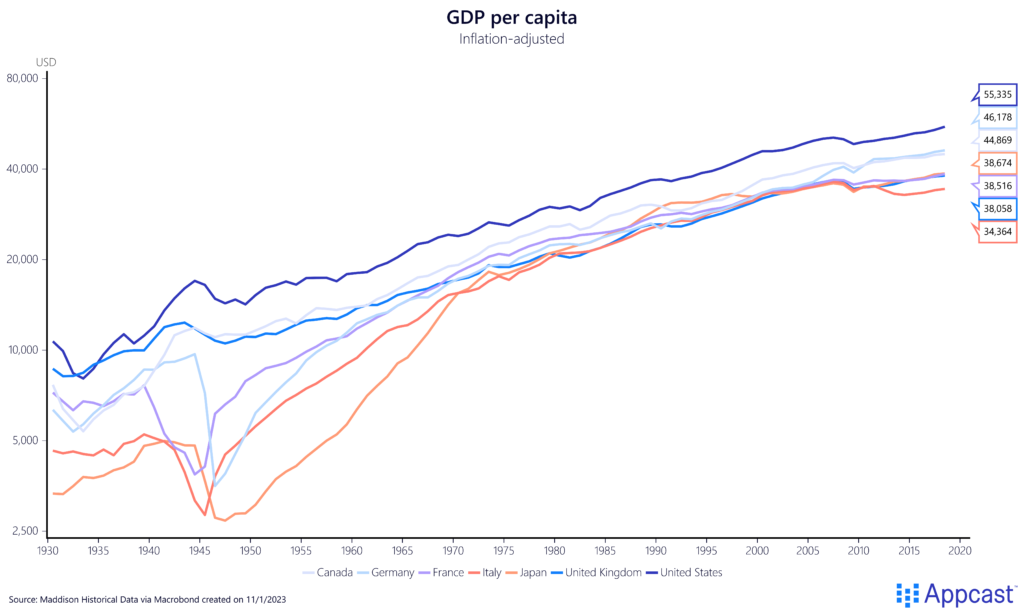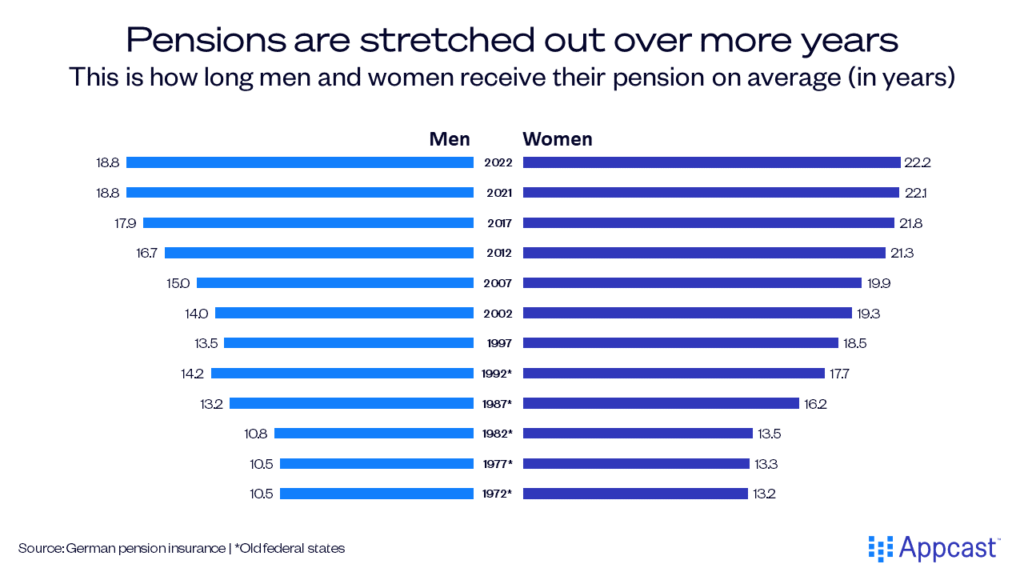Economic possibilities for our grandchildren
John Maynard Keynes was one of the most famous economists of the last century. While most of his work covered macroeconomic theory, in his 1930 essay, “Economic Possibilities for our Grandchildren,” Keynes discussed the possibility of economic development and increases in living standards during the following century.
Keynes made two famous predictions: (1) Living standards would increase by 4- to 8-fold over the subsequent century and (2) workers would only labor 15 hours per week. The first turned out to be shockingly accurate, while the second has been ridiculed as wildly off-the-mark. But as global working hours have declined substantially and paid vacation days and time spent in retirement have increased, Keynes was more right than wrong.
Looking at the data, one can see that his long-run projection of living standards was pretty accurate. Between 1930 and 2018, U.K. GDP per capita increased from about $6,800 to about $38,000 USD (inflation-adjusted). This corresponds to an increase of about 440% – and there’s still a decade and change to go. Moreover, the U.K. was one of the richest countries back in 1930, so has actually seen relatively slower growth than other countries since then. Keynes’ prediction that living standards would increase more than fourfold was thus right on the money.

No 15-hour work week but still…
Keynes’ second prediction that we would see a 15-hour work week in 2030 has been widely ridiculed. And fairly so! It truly does sound like something out of a utopian society that is out of reach for us. However, as I will show, workers are working far less than they were a few decades – let alone a century – ago. We also have significantly more vacation days and enjoy much longer retirements.
Richer countries can afford to work less
Let’s start with a straightforward fact that shouldn’t be a massive surprise to anybody: There is a large negative relationship between average income levels (or labor productivity) and average working hours. People in poorer countries work more, whereas people in very rich countries like Switzerland and Germany have some of the lowest average annual working hours in the world.
But this has not always been the case. People worked far longer hours decades ago when all advanced economies were poorer. As incomes rise, we can simply afford to work less.

Annual working hours are way down
Average annual working hours have therefore steadily declined over the last century. Data compiled by economic historians shows that they were close or even exceeding 3,000 hours per year in advanced economies in 1870. By 1930, when Keynes wrote his essay, they were already closer to 2,500 hours per year. Today, average annual working hours are in the 1,400 to 1,800 hours per year range across advanced economies.
Germany has one of the lowest average annual working hours in the world. The country has seen a more than 35% reduction in annual average working hours from about 2,130 in 1930 to about 1,350 today.

The number of vacation days has gone up
One of the main reasons working hours have declined so much in recent decades is because the number of vacation and holiday days have increased over time. While in 1900 Germans had less than 20 days off from work, on average, that number has doubled in recent years to over 40.
With about 40 paid days off from work, a four-day week would basically be feasible already today. However, most people prefer to bundle their days off from work so they can afford to go on vacation for a week or two at a time.

More people work part-time
A second, and more important reason, why annual working hours have fallen is because an increasing number of workers are only employed part-time. It would be a mistake to assume that this trend is involuntary. Yes, some workers would like to work full time and are unable to, but most people working part time choose to do so.
The share of part-time employees in Germany has increased from about 20% in the 1980s to more than 40% today. For women, the share of part-time workers increased from less than 40% to about 60% over the same period. Women have joined the labor force in droves since the 1980s, but many responsibilities related to childcare and obviously childrearing still fall disproportionately on women. Therefore, many women in the workforce decide to work part-time only, especially in countries in which childcare facilities are either extremely expensive or only run for half of the day, or both.

Looking at the distribution of working hours within Germany, one can see that close to 25% of workers are working either short (10.0-19.9 hours) or long (20.0-34.5 hours) part-time. Arithmetically, more part-time work leads to a reduction of the average for the country as a whole.
The data also shows that some 60% of workers are still working long or overlong full-time, meaning more than 40 hours per week. So, Keynes’ utopia certainly isn’t a reality yet for most workers.

The number of years in retirement has steadily increased
At the time of Keynes’ writing though, most people had to work for most of their lifespan and only enjoyed very short spells of retirement, if at all. Modern pension systems did not exist yet.
Just in the last five decades, the duration of time people spend in retirement has massively increased. This is, by the way, one of the reasons why pension systems will become increasingly strained by rapidly aging societies and increasing life expectancy.
For women in Germany, the duration of pension receipts increased by almost 10 years since 1950 to more than 22 years today, while for men it increased by 8 years to a total of more than 18 years today.

What does that mean for recruiters?
In recent decades, more workers have decided to work part time. A substantial share of this is because more women have been joining the workforce. Because of a lack of gender equity, women require more flexibility as they disproportionately handle many of the responsibilities of child-rearing – and obviously childbearing.
With the looming worker shortage in advanced economies due to aging societies, it is imperative for recruiters to accept this new reality that more workers want to and require to work part-time. Furthermore, with incomes steadily increasing in recent decades, many full-time employees also do not desire to work extremely long hours anymore. A better harmony between work life and personal life has become more important for many and rightly so. In a tight labor market, companies and recruiters should emphasize perks like flexibility regarding working hours and a decent work-life balance.
While Keynes’ utopia of a 15-hour work week certainly isn’t a reality for most, one should not forget to what extent working hours have fallen and paid days-off have increased in recent decades. Moreover, most people nowadays spend an additional decade not working in retirement as life expectancy continues to increase. Compared to those in 1930, we’re far closer to utopia.







